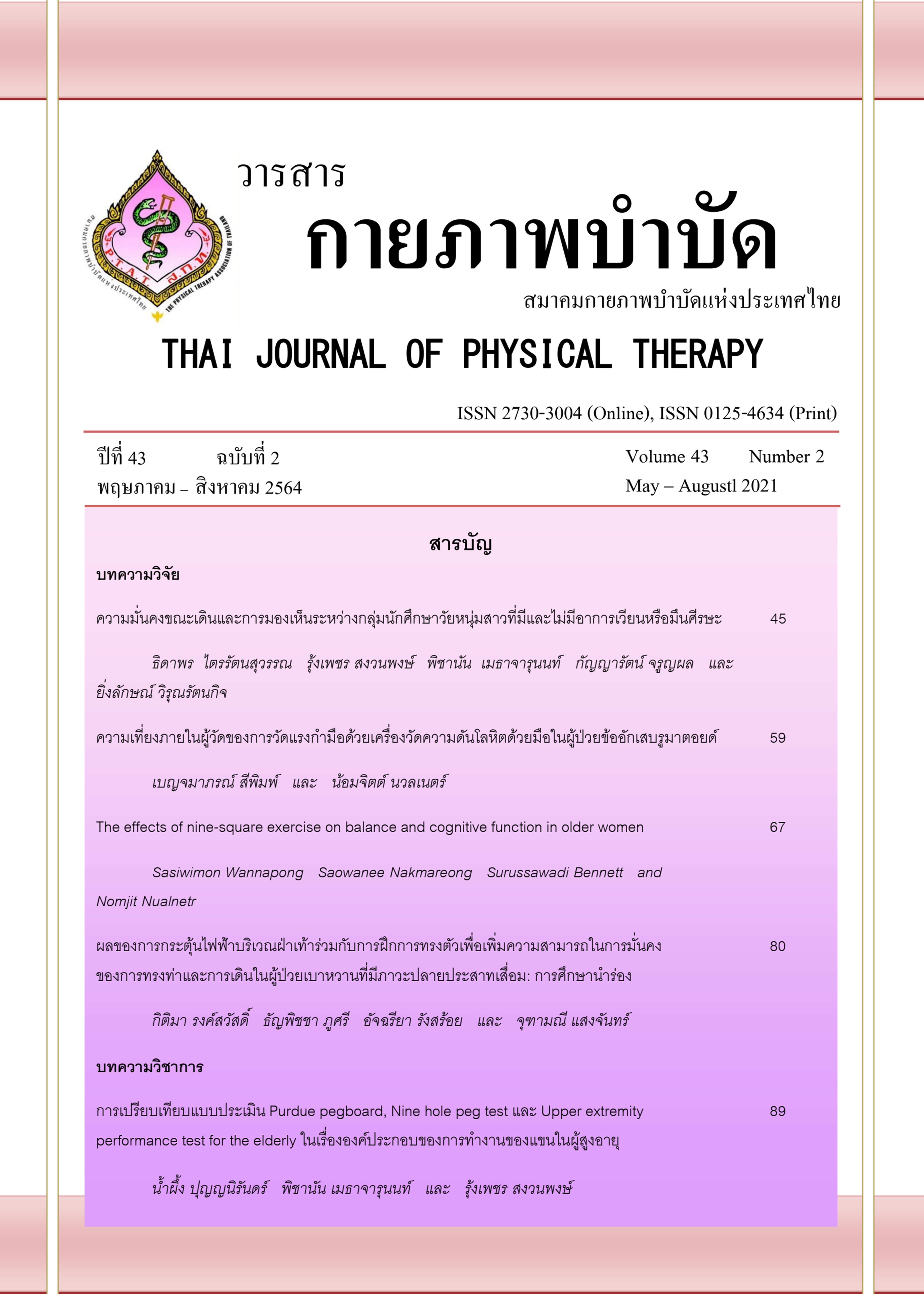ผลของการกระตุ้นไฟฟ้าบริเวณฝ่าเท้าร่วมกับการฝึกการทรงตัวเพื่อเพิ่มความสามารถในการมั่นคงของการทรงท่าและการเดินในผู้ป่วยเบาหวานที่มีภาวะปลายประสาทเสื่อม: การศึกษานำร่อง
Main Article Content
บทคัดย่อ
ที่มาและความสำคัญ: ผู้ป่วยเบาหวานชนิดที่ 2 ที่มีภาวะปลายประสาทเสื่อม พบว่ามีการลดลงของการรับความรู้สึกบริเวณฝ่าเท้า ซึ่งส่งผลต่อความสามารถในการทรงตัวเป็นสาเหตุให้เกิดภาวะเสี่ยงล้ม จากการศึกษาที่ผ่านมาพบว่าการฝึกการทรงตัวและการกระตุ้นไฟฟ้าบริเวณฝ่าเท้าในระดับความรู้สึก สามารถเพิ่มความสามารถในการทรงตัวในผู้ป่วยเบาหวานที่มีภาวะปลายประสาทเสื่อมได้ อย่างไรก็ตาม การศึกษาที่ผ่านมาส่วนใหญ่เป็นการรักษาเพียงอย่างเดียว ยังไม่มีการศึกษาที่ดูผลร่วมของการรักษาทั้ง 2 อย่าง
วัตถุประสงค์: เพื่อศึกษาผลของการกระตุ้นไฟฟ้าที่บริเวณฝ่าเท้าร่วมกับการฝึกการทรงตัวเป็นเวลา 4 สัปดาห์ต่อความมั่นคงในการทรงท่าและความสามารถในการเดินในผู้ป่วยเบาหวานชนิดที่ 2 ที่มีภาวะปลายประสาทเสื่อม
วิธีการวิจัย: ผู้ป่วยเบาหวานชนิดที่ 2 ที่มีภาวะปลายประสาทเสื่อมจำนวน 7 คน ได้รับการกระตุ้นด้วยไฟฟ้าที่บริเวณฝ่าเท้าร่วมกับการฝึกการทรงตัวในท่ายืนเป็นระยะเวลา 3 ครั้ง/สัปดาห์ 4 สัปดาห์ติดต่อกัน โดยการประเมินการแกว่งของลำตัวของโดยใช้ Lord’s sway meter ใน 4 เงื่อนไข (ลืมตายืนบนพื้นแข็ง หลับตายืนบนพื้นแข็ง ลืมตายืนบนพื้นนิ่ม และหลับตายืนบนพื้นนิ่ม) และประเมินความเร็วในการเดินด้วยแบบประเมิน 10 meter walk test ซึ่งทำการประเมินก่อนและหลังจากการฝึก
ผลการวิจัย: ผลการศึกษาพบว่าหลังจากการฝึก 4 สัปดาห์ติดต่อกันผลการแกว่งของลำตัวทั้ง 4 เงื่อนไขและความเร็วในการเดินของผู้ป่วยดีขึ้นอย่างมีนัยสำคัญ (p < 0.05) เมื่อเทียบกับก่อนการฝึก
สรุปผล: ผลของการกระตุ้นไฟฟ้าที่บริเวณฝ่าเท้าร่วมกับการฝึกการทรงตัวเป็นเวลา 4 สัปดาห์ช่วยเพิ่มความมั่นคงในการทรงท่าและความสามารถในการเดินในผู้ป่วยเบาหวานชนิดที่ 2 ที่มีภาวะปลายประสาทเสื่อม
Article Details
เอกสารอ้างอิง
Cho NH, Shaw JE, Karuranga S, Huang Y, da Rocha Fernandes JD, Ohlrogge AW, et al. IDF Diabetes Atlas: Global estimates of diabetes prevalence for 2017 and projections for 2045. Diabetes Res Clin Pract. 2018; 138: 271–81.
IDF. Retrieved February 25, 2019, Available from: https://www.idf.org/our-network/regions-members/western-pacific/members/115-thailand.html
American Diabetes Association. Complications | ADA [Internet]. [cited 2019 Feb 25]. Available from: https://www.diabetes.org/diabetes/ complications
Ibrahim A. IDF Clinical Practice Recommendation on the Diabetic Foot: A guide for healthcare professionals. Diabetes Res Clin Pract. 2017; 127: 285–7.
Davies M, Brophy S, Williams R, Taylor A. The prevalence, severity, and impact of painful diabetic peripheral neuropathy in type 2 diabetes. Diabetes Care. 2006; 29(7): 1518–22.
Turcot K, Allet L, Golay A, Hoffmeyer P, Armand S. Investigation of standing balance in diabetic patients with and without peripheral neuropathy using accelerometers. Clin Biomech. 2009; 24(9): 716–21.
Dixon CJ, Knight T, Binns E, Ihaka B, O’brien D. Clinical measures of balance in people with type two diabetes: A systematic literature review. Gait Posture. 2017; 58: 325–32.
Sturnieks DL, Arnold R, Lord SR. Validity and reliability of the swaymeter device for measuring postural sway. BMC Geriatr [Internet]. 2011 Dec [cited 2019 Mar 15]; 11(1). Available from: http://bmcgeriatr. biomedcentral.com/articles/10.1186/1471-2318-11-63
Graham JE, Ostir GV, Fisher SR, Ottenbacher KJ. Assessing walking speed in clinical research: a systematic review. J Eval Clin Pract. 2008; 14(4): 552–62.
Peters DM, Fritz SL, Krotish DE. Assessing the reliability and validity of a shorter walk test compared with the 10-Meter Walk Test for measurements of gait speed in healthy, older adults. J Geriatr Phys Ther. 2013; 36(1): 24–30.
Ahmad I, Hussain E, Singla D, Verma S, Ali K. Balance Training in Diabetic Peripheral Neuropathy: A Narrative Review. JSM Diabetol Manag. 2017; 2(1): 1–9.
Ites KI, Anderson EJ, Cahill ML, Kearney JA, Post EC, Gilchrist LS. Balance interventions for diabetic peripheral neuropathy: a systematic review. J Geriatr Phys Ther. 2011; 34(3): 109–16.
Najafi B, Talal TK, Grewal GS, Menzies R, Armstrong DG, Lavery LA. Using Plantar Electrical Stimulation to Improve Postural Balance and Plantar Sensation Among Patients With Diabetic Peripheral Neuropathy: A Randomized Double Blinded Study. J Diabetes Sci Technol. 2017; 11(4): 693–701.
Najafi B, Crews RT, Wrobel JS. A Novel Plantar Stimulation Technology for Improving Protective Sensation and Postural Control in
Patients with Diabetic Peripheral Neuropathy: A Double-Blinded, Randomized Study. Gerontology. 2013; 59(5): 473–80.
International Diabetes Federation, Sinclair A, Dunning T, Colagiuri S. Managing older people with type 2 diabetes: global guideline. [Internet]. [cited 2019 Oct 25]. Available from: https://ifa.ngo/wp-content/uploads/2014/02/ IDF-Guideline-for-Older-People.pdf
Institute of Geriatric Medicine. Medical technology assessment: comparison of relationship between Mini-Mental State Examination Thai Version (MMSE-Thai) 2002 and Thai Mini-Mental State Examination (TMSE) for screening the elderly with dementia. Bangkok: CG tool Company Limited; 2008.
Thakral G, LaFontaine J, Najafi B, Talal TK, Kim P, Lavery LA. Electrical stimulation to accelerate wound healing. Diabet Foot Ankle. 2013; 4.
Pan X, Bai J. Balance training in the intervention of fall risk in elderly with diabetic peripheral neuropathy: A review. Int J Nurs Sci. 2014; 1(4):441–5.
Fortaleza AC de S, Chagas EF, Ferreira DMA, Mantovani AM, Barela JA, Chagas EFB, et al. Postural control and functional balance in individuals with diabetic peripheral neuropathy. Rev Bras Cineantropometria Amp Desempenho Hum. 2013; 15(3):305–14.


